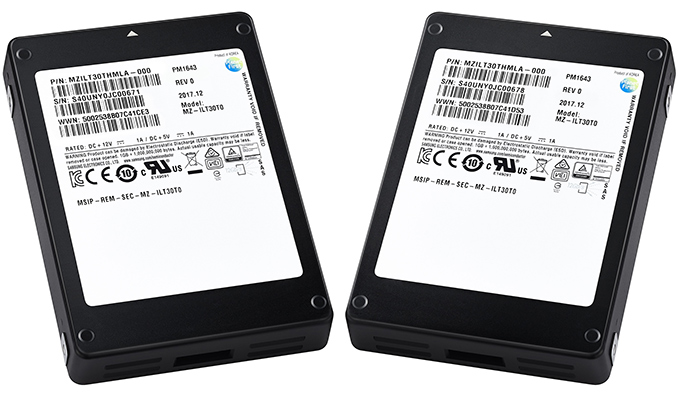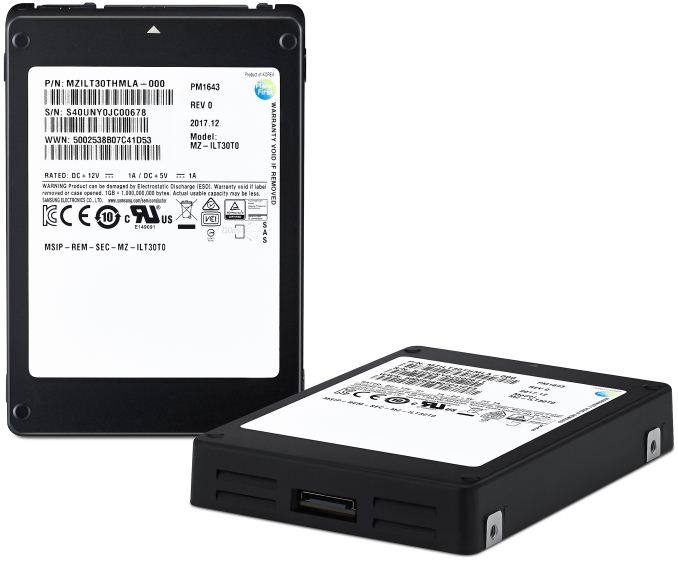Samsung 30.72 TB SSDs: Mass Production of PM1643 Begins
by Anton Shilov on February 20, 2018 8:30 PM EST
Update 2/21: Adding power consumption figures for the PM1643 drive, new features.
Samsung this week announced that it has started mass production of its PM1643-series SSDs. These are monstrous data storage devices, with up to 30.72 TB capacity each. The new drives use Samsung’s 64-layer 512Gb TLC V-NAND memory chips stacked in 1 TB packages. Later this year Samsung plans to expand the PM1643 lineup with SSDs featuring other capacities.
Samsung’s PM1643 30.72 TB SSD is the company’s highest-capacity mass-produced drive to date. It is designed primarily for read-intensive workloads, and features an SAS-12 Gbps interface. Samsung rates its PM1643 for one DWPD (drive write per day) throughout five years, which indicates a very high endurance of roughly 56 PB for the drive. The choice of the interface and robust endurance rating naturally suggest that we are dealing with a drive for mission-/business-critical applications. Some of the features of the PM1643 that Samsung is willing to discuss right now (metadata protection, power loss protection, data recovery, end-to-end data protection, encryption, etc.) confirm that the drives are indeed aimed at servers that require advanced reliability.
The PM1643 is based on Samsung’s proprietary controller architecture as well as 512 Gb 64-layer TLC V-NAND memory chips - 16 of them are stacked together to create 1 TB packages, over 40 of such packages are used for the 30.72 TB drive, giving sizeable overprovisioning. The new SSDs also carry 40 GB of stacked DDR4 memory (8 Gb DRAM chips interconnected using TSVs), which is in line with the configurations of other drives.
When compared to the previous-generation PM1633a SSDs released in 2016, the new PM1643 offers both double the capacity and also considerably on-paper higher performance. Samsung claims that the PM1643 30.72 TB SSD features sustained sequential read and write speeds of up to 2100 MB/s and 1700 MB/s, respectively. As for peak random read/write performance, the new PM1643 drive is rated for sustained 400K and 50K IOPS, respectively. Samsung yet has to announce sustained sequential and random performance numbers, but it is clear that the new SSDs are intended faster than their direct predecessors.
Update 2/27: The performance numbers disclosed by Samsung indicate sustained, not peak performance.
The Samsung PM1643 SSDs will come in a 2.5-inch form factor, but at 15mm. The new drives support configurable run-time power consumption options of 9W ~ 13.5W (the lower consumption means lower performance), which allows to choose between power and performance per system and application. Since the drives consume an exact same amount of power as the PM1633a 15.36 TB, it is drop in compatible with systems that use the PM1633-series drives. Furthermore, GB-per-Watt consumption of the new drives is at least two times lower when compared to the PM1633a 15.36 TB model.
| General Specifications of Samsung PM1643 and PM1633a SSDs | ||||
| PM1643 30.72 TB | PM1633a 15.36 TB | |||
| Controller | Samsung proprietary controller | |||
| NAND | Samsung's 512 Gb 64-layer TLC NAND |
Samsung's 256 Gb 48-layer TLC NAND |
||
| DRAM Cache | 40 GB DDR4 SDRAM | 16 GB DDR3 SDRAM | ||
| Sequential Read | 2100 MB/s | 1200 MB/s | ||
| Sequential Write | 1700 MB/s | ? | ||
| Random Read 4KB | 400K | 200K | ||
| Random Write 4KB | 50K | 32K | ||
| Endurance | 1 DWPD (Drive Write Per Day) | |||
| 56 PB over 5 years | 28 PB over 5 years | |||
| Interface and Form-Factor | 2.5"/15mm SAS-12 Gbps | |||
Samsung started mass production of its PM1643 SSDs in January and has already shipped the first batch to an undisclosed customer. Pricing of individual 30.72 TB drives remains unknown, but we expect it to be thousands of dollars per unit, even at bulk. Later this year Samsung plans to introduce additional capacity points to the PM1643 lineup: the family will include drives featuring 15.36 TB, 7.68 TB, 3.84 TB, 1.92 TB, 960 GB and 800 GB of usable NAND flash.
Related Reading
- Samsung’s PM1633a Now Available: $10k for 15 TB, $6k for 7 TB
- Samsung Begins to Ship 15.36 TB SSD for Enterprise Storage Systems
- Memblaze Launches PBlaze5 SSDs: Enterprise 3D TLC, Up to 6 GB/s, 1M IOPS, 11 TB
- Micron Introduces 9200 Series Enterprise NVMe SSDs
- Seagate Refreshes Enterprise SSDs With 3D NAND
Source: Samsung











22 Comments
View All Comments
sjkpublic@gmail.com - Wednesday, February 21, 2018 - link
You would lose. 30TB in a 2.5" / 15mm form factor alone is amazing. Speed another. Write endurance another. 15K would be my over/under.Kevin G - Tuesday, February 20, 2018 - link
What is that weird port on the drive? It isn't he front port, you can see a SFF8482 port in the first picture but I'm referring to the port on the other side of the drive.MrSpadge - Wednesday, February 21, 2018 - link
That's the NSA port for speedy access. They'll tell you, though, it was introduced by the Chinese or Russians. Or whoever is declared the "evil of the day"./joke
StefanR - Wednesday, February 21, 2018 - link
RGB lighting for HEDT use ? :-Phirschma - Wednesday, February 21, 2018 - link
That for a cable that keeps the spindles synchronized, for RAID :)XabanakFanatik - Wednesday, February 21, 2018 - link
How is it rated at 2100MB/s read and 1700MB/s write with a single SAS 12Gb/s which would put maximum theoretical throughput at 1500MB/s?torbendalum - Wednesday, February 21, 2018 - link
Look at the port, it's not a SAS port, it's a NVMe port, smal NVMe drive you plug into m2 ports, the big ones like this has a NVMe cable to a many port NVMe cardcdillon - Wednesday, February 21, 2018 - link
The Samsung press release specifically says it is 12Gb/s SAS, not PCIe (there's no such thing as an "NVMe port", but there are PCIe ports which you can use with NVMe). The news release does not mention how many channels specifically, but most enterprise drives use a dual-channel SAS interface which means the maximum interface throughput would be closer to 2400MB/sec (SAS uses 8b/10b serial encoding which makes for convenient bandwidth-math).jhh - Wednesday, February 21, 2018 - link
Not sure how many systems can actually use both SAS ports, and that is typically used with active/standby controllers. So, the drive can do it, but the supporting system?kalgriffen - Wednesday, February 21, 2018 - link
There are active/active systems available as well.